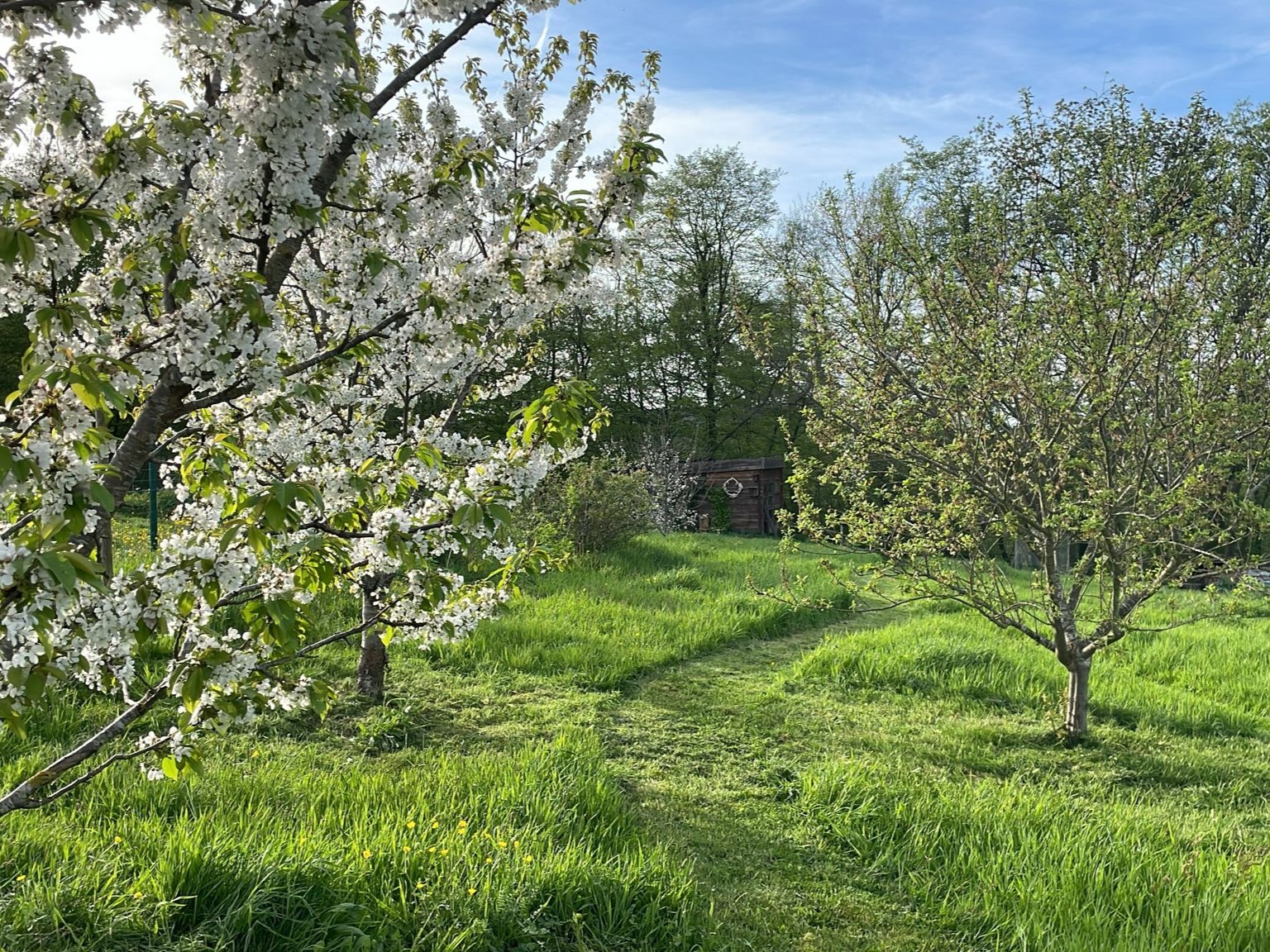
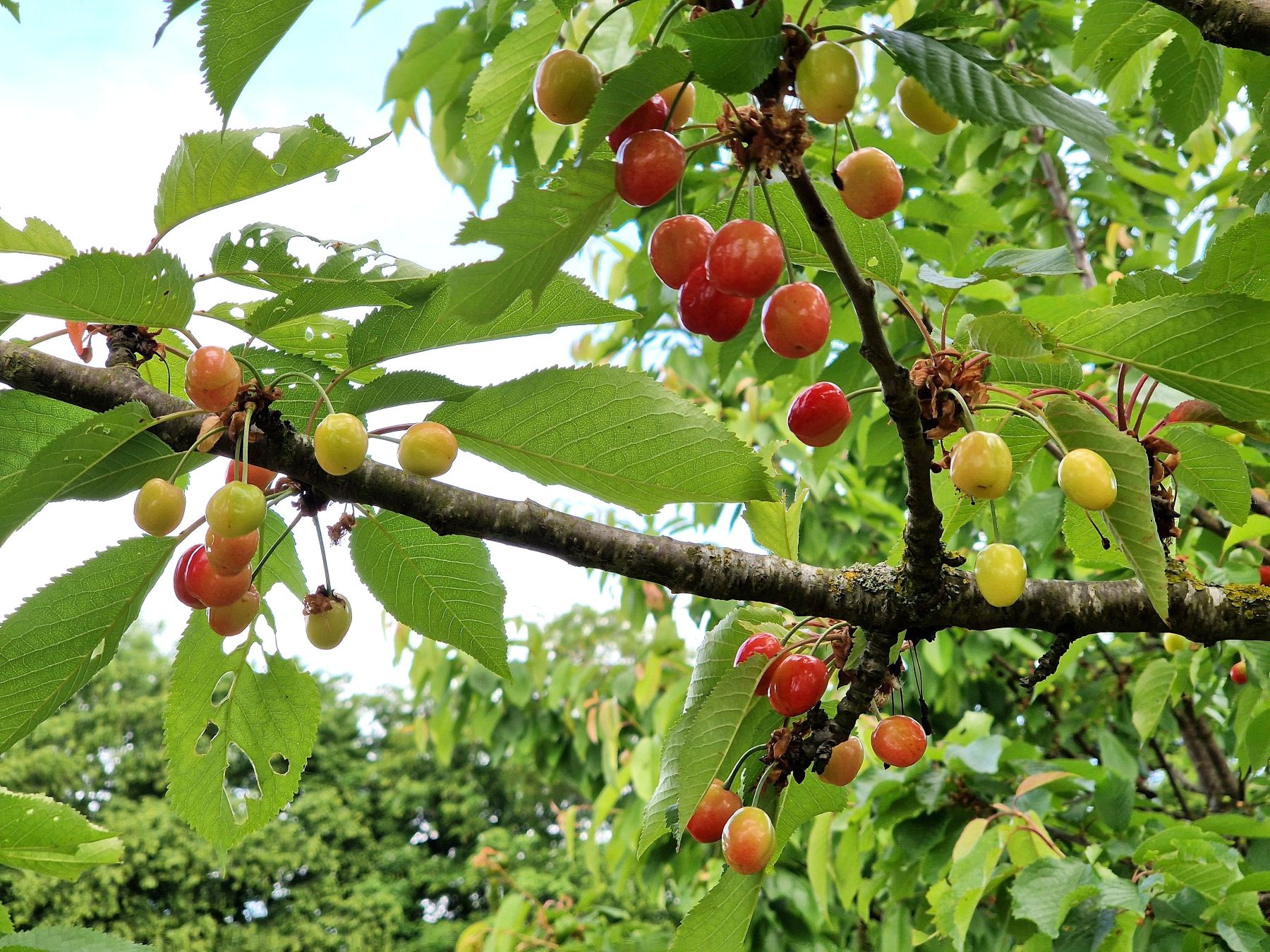

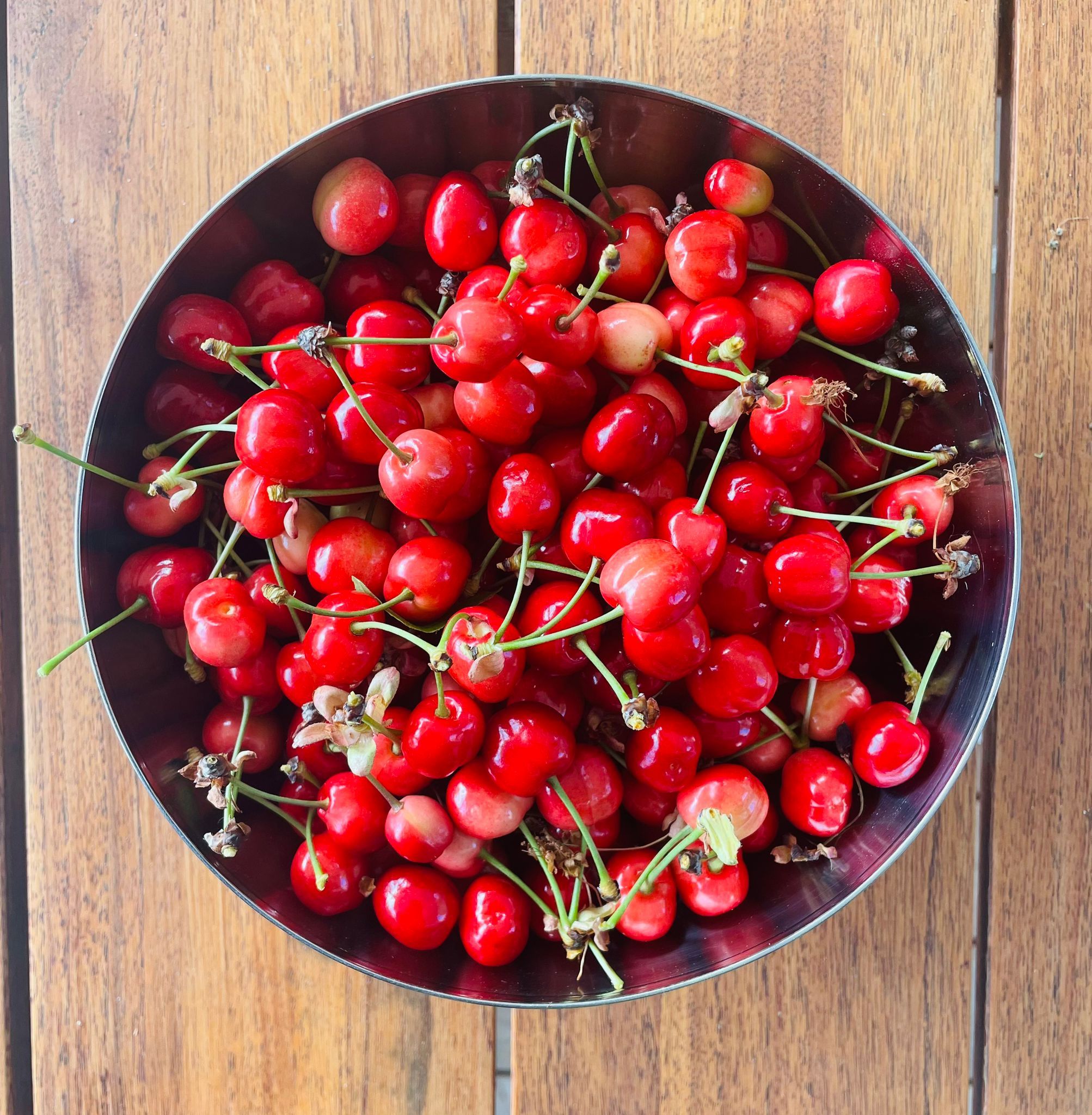
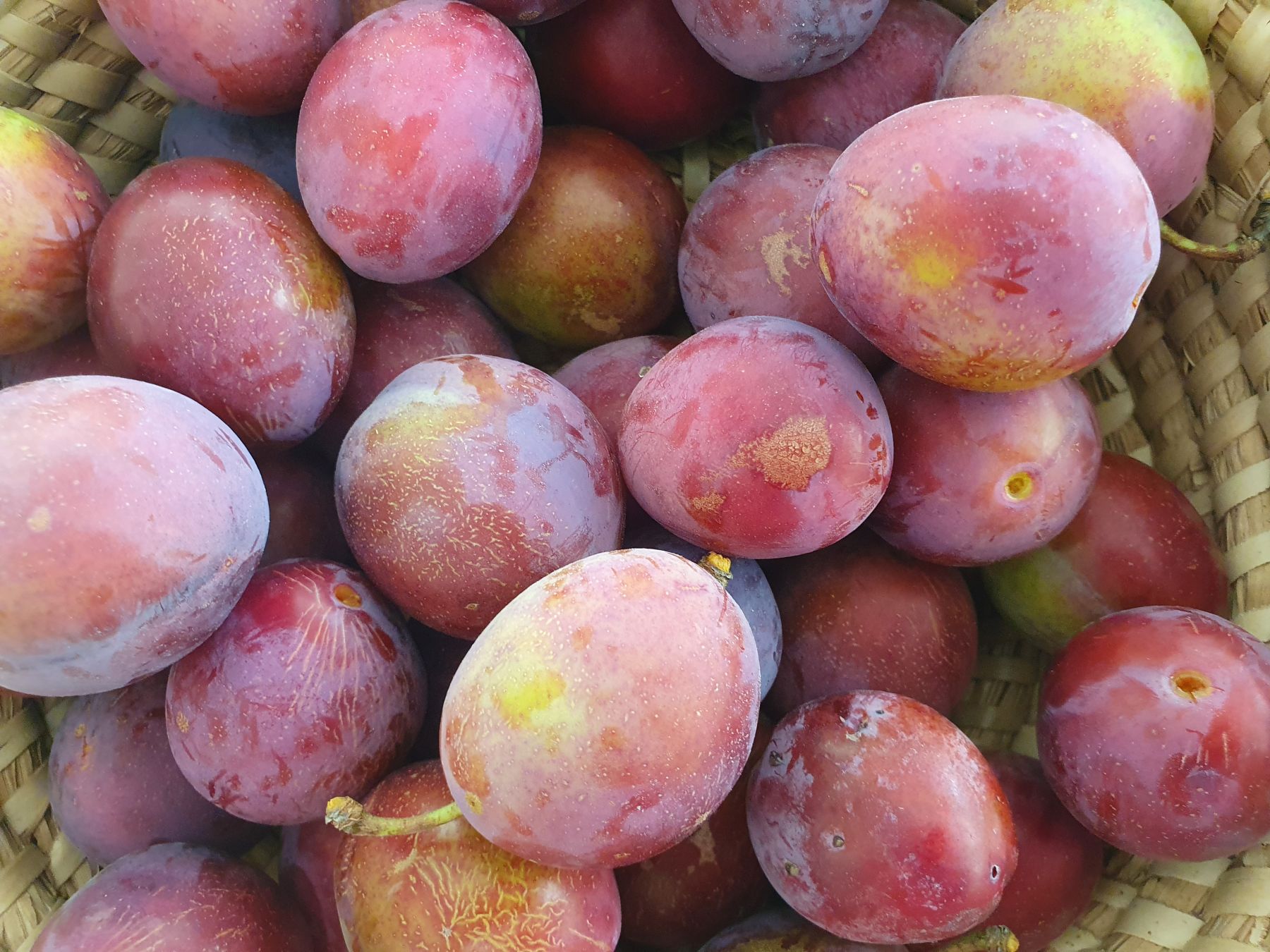
Fruit fest
23/05/2025
A fruit tree fit quite well in an ecological garden: it not only produces delicious fruit, but also provides nectar for bees and butterflies in early spring, food for numerous animals, shade and nesting opportunities. A mini orchard also adds some vertical layering to your garden.
The white and pink blossoms of the fruit trees have aleady faded, the cherries are turning light red, the mini plums are full of promise and the start of the apples show that cross-pollination was good this year. The mason bees from our insect hotel, our neighbour's honey bees and other wild bees have done the job well. It is important to have enough other flowering plants and shrubs in your garden in early spring so that pollinators have enough nectar and pollen supply and stay in your garden. This ensures a good fruit harvest, although of course it should not freeze during flowering.
Most common fruit trees - apples, pears and cherries - require cross-pollination between different varieties of the same fruit species. You then need at least two apple varieties flowering at the same time or in combination with wild apple is also possible. Then again, most cherries, apricots and some plums are self-pollinating so you only need one of those, although you will get better and more fruit if you plant several varieties close together. So good to know if you're thinking about fruit in the garden.
Fruit trees need a lot of sun and do not tolerate wet soil. Too much wind can also be problematic, which is why you often see hedges as windbreaks around orchards to create a microclimate. It is best to keep the grass short under the crown to avoid competition with other plants. Long grass also attracts voles that feed on the roots. Mowing will keep it short. Grazing is also used in orchards, although you have to protect the trees. Fruit trees are best planted between mid-November and the end of February and only when the soil is not too wet and there is no frost. That way, the plant invests in root growth during the winter and starts the growing season stronger. The planting distance for tall trunks is 8-15m, for medium trunks 3-6m and for low trunks 2-4m. You should therefore provide enough space thinking about the final image of how large your tree will grow.
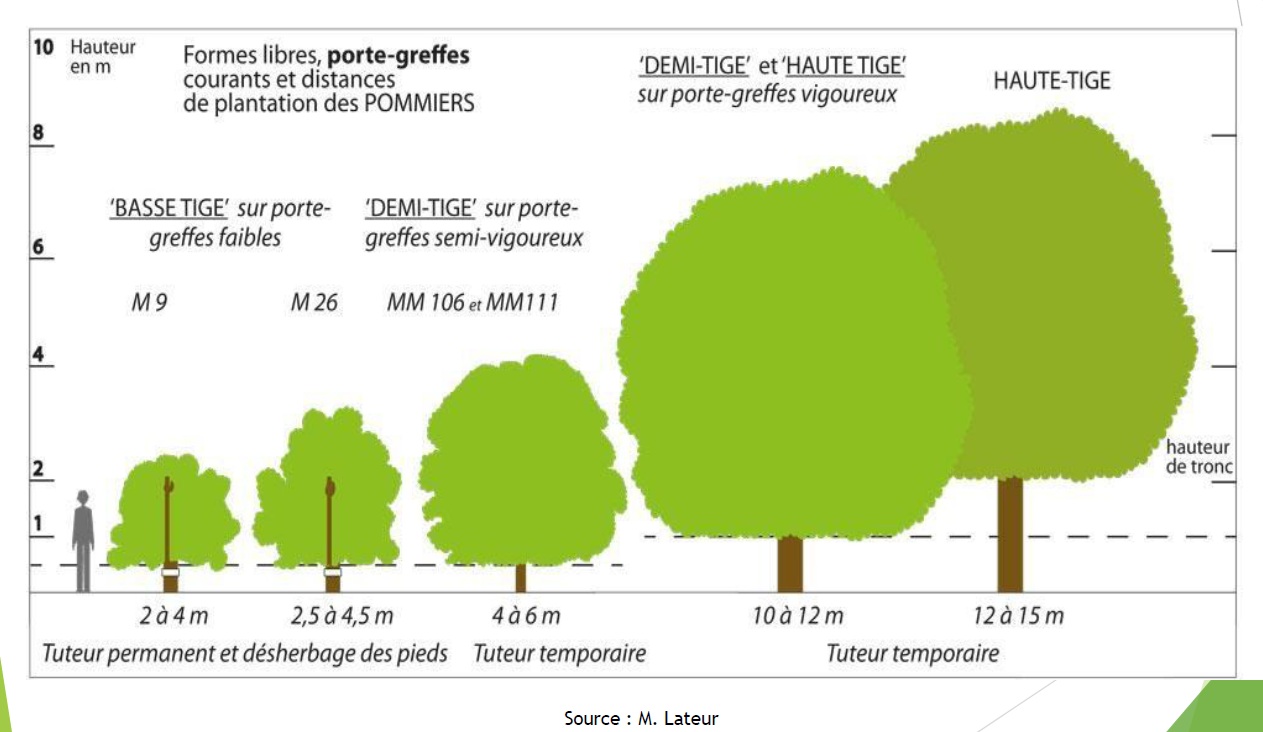
Which fruit variety you choose obviously depends on your taste, but if you have enough space in your garden, definitely go for tall-stemmed fruit trees. These are grafted at 1.8-2m, so you walk easily under them. They are more robust varieties, give tastier fruit, root deeply and live a long time, up to 100 years for some pear varieties! The best thing is that they only need limited maintenance; a topiary for the first 5-7 years and maintenance pruning after 15 years. Only in the first 5 years do you support them with a stake. With low-trunk or half-trunk - grafted at 0.6 & 1.2 m - you need to prune every year for good production, provide lifelong support and low-trunk you need to replace after only 15 years. You do need just a bit more patience for the first pick with tall-stem, but after 7 years you can enjoy decades. With old varieties of tall fruit trees, you also preserve our natural heritage, because many older varieties are lost.
When choosing your fruit species and fruit variety, it is also useful to consider whether, for example, you prefer fresh apples or if you prefer a variety that preserves for a long time, gives good juice or is ideal for processing, such as applesauce, stew apple or cider? The certifruit label from the University of Gembloux guarantees good quality and tells you which varieties do well in your region, be sure to check it out. Once you know which varieties appeal to you and have chosen the right combination for good cross-pollination, look for a grower in your area, preferably one who grafts the trees himself. The advantage is that their trees are grown in the same soil and are therefore more likely to thrive in your garden. Order your chosen fruit variety(ies) on time. So if you dream of having your own fruit tree, it's good timing to look into it now.
Of course, berries and nuts are also delicious in the garden, but they deserve their own blog, so be sure to keep following us here. Want help making the right choices of fruit trees? Then don't hesitate to contact us! 🍏🍐🍑🍒 or just drop by during our open garden days on 7 & 8 June. Frank knows all about it and will be happy to tell you more.
Comments
- Heel nuttig en weer wat bijgeleerd 😊 ( onze eenzame aangeplante appelboom zal dus niet veel vruchten leveren - toch drie beloftevolle miniappeltjes aangetroffen 😉) (Johan)
- Thank you An, always so helpful. I dream to come visit your garden. Let's see when that will happen. (Railovy)
- Dag Johan, dank je! Met wat geluk staat er een wilde appel of appelboom van de buren in de buurt, je kan dus ook zeker naar de omgeving rond je tuin kijken als je je fruitrassen kiest. (An)
- Thanks Railovy, you are more than welcome to visit anytime ! Enjoy your garden project too. (An)
- Onze tuin in de Famenne (Grandhan) is niet zo gastvrij voor fruitbomen. Enkel zoete kers (de wilde versie) en meidoorn en sleedoorn gedijen er. Appel, peer, kers.. sterven telkens door scheuren in de schors. De ondergrond is schist en de bodemlaag is erg dun. Verwilderde pruim en wilde appel lukken op de horizontale stukken. (Johan Claessens )
- Inderdaad, Johan, als de bodemlaag te dun is, dan zullen de fruitbomen niet goed wortelen en bij de minste stress het moeilijk hebben, maar het scheuren zelf kan aan verschillende factoren liggen waaronder zonnebrand het bekendste : als de boom in volle zon staat, is het aangeraden om in het voorjaar de stam te witten (dit ontsmet ook de boom), want temperatuursverschillen tussen dag en nacht in het voorjaar veroorzaken scheuren. Eventueel kan je bij een kweker in de buurt bv. Pépinières de Mormont advies vragen en soorten/variëteiten selecteren die aangepast zijn aan jullie bodem. Hou ons zeker op de hoogte! (Frank)
Add a comment


